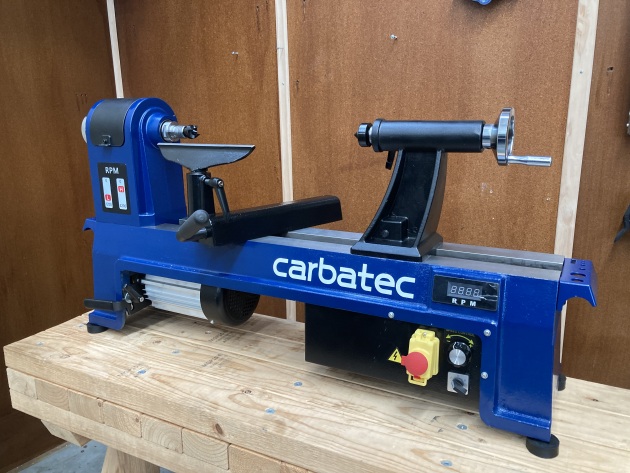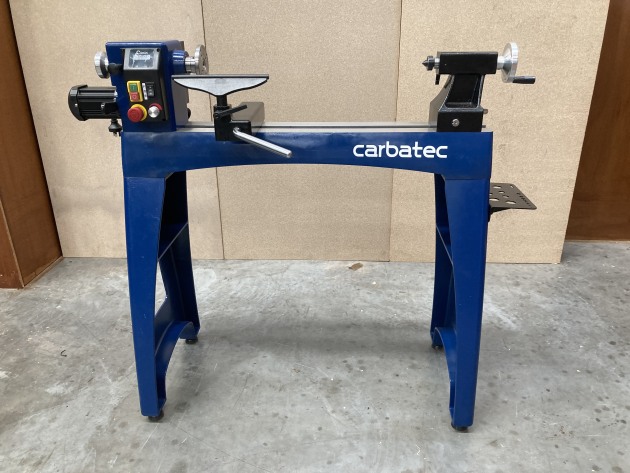TESTED: Carbatec midi and floor lathes
Words and photos: Andrew Potocnik
We’re spoilt for choice when it comes to lathes, and now Carbatec has added a range to provide even more, depending on your needs.
Carbatec WL–B1420P midi lathe
The WL–B1420P is powered by a 1hp (750 watt) variable speed motor that hums along quietly even at a top speed of 3200rpm. It comes with all the features you expect of a full size lathe, offering a generous swing of 350mm over the bed and 500mm between centres, so you can comfortably turn coffee table legs with the two-step pulley set on the high range, but also turn a bowl or platter using the lower range setting which will provide lots of torque.
All components are solid and cleanly finished. A well machined bed allows for easy movement of the tailstock and saddle, while large locking levers enable them to be fixed into position without fuss. The toolrest is 200mm long and has a 25mm post, which coupled with the solid saddle provides ample support for the tool, even when extended out from the bed. There’s no flex, as can be experienced with some cheaper machines. I was impressed with the bulk and finish of these components.
The speed dial makes it easy to see how fast the lathe is running, while the reverse switch lets you run the machine backwards, a feature some turners like for finish sanding. The problem is this also allows a faceplate or chuck to unwind from the spindle, so a couple of grub screws have been added to the 100mm diameter face plate to hold it securely in place.
The control box is conveniently mounted on the right side of the lathe allowing easy access for right handers. As is expected these days, the on / off button features a safety cap so it’s easy to turn the lathe off, especially of there’s an emergency.
If you’re keen on turning, but don’t have much space in your workshop, this lathe will allow plenty of scope and only take up bench space, or you could build your own stand. All in all, this is a good machine that will satisfy the needs of any intermediate level turner or act as a very handy back-up for your larger lathe.
Carbatec WL–1324P compact floor lathe
The WL–1324P compact floor lathe is also a midi which comes with a dedicated stand. It has a slightly smaller swing of 328mm (1" less) and 40mm more between centres, so there’s still plenty of scope in what you can make.
Again, components are solidly made and well finished, allowing the tailstock and saddle to move freely, and thanks to the large locking levers, lock firmly into place.
Most features of this lathe are similar to the bench-mounted machine. A 100mm faceplate is provided, however the tailstock centre is heavy duty. The longer toolrest has a hardened rod added to its top edge providing smooth travel of scrapers and gouges over its surface, meaning that it will need little if any ‘dressing’ in the future. But the big difference between the two is in the headstock.
Obvious, is that the control box is mounted here with its dedicated emergency stop button. Not obvious, is the triple ball bearing spindle and 1hp ‘servo’ motor and inverter, said to provide better power delivery. I have found this combination will not waver under the resistance generated when working on large or heavy pieces of wood.
Carbatec WL-1624P floor model lathe
The WL-1624P deluxe floor lathe is the real workhorse and aimed directly at the serious woodturner. There are a number of features that make it stand out from the crowd, beginning with the 2hp (1500 watt) induction motor and inverter. There is a swing over the bed of 408mm, but only 560mm between centres, so it’s aimed more at the bowl or faceplate turner rather than those keen on turning long spindles.
The headstock rotates to about 45° which allows for a more comfortable stance when turning large discs. Alternatively, you can rotate it to the next stop at 90° so you can stand right in front of your workpiece. This also enables you to turn discs of even greater diameter. To cater for this, there is an extension piece that fits between the toolrest and saddle; however, I have never found this option to be satisfactory on its own and suggest adding a piece of wood or metal reaching from below the toolrest to the floor.
As you’ll need to access the control box with ease, it has been removed from the body of the lathe and can be moved to anywhere you feel comfortable with. Magnets fitted to the back enable you to attach it to the stand or front of the bed. Again there is a dedicated stop button, along with the reverse option, and hence the 150mm faceplate has grub screws too.
Not only is there extra power, but there’s also more weight (just under 200kg) and an increased spindle size of 1-1/4" x 8tpi, so be careful to purchase the correct insert for a scroll chuck, not getting mixed up with the more common M30 threads that most lathes come with these days.
In conclusion, all three lathes are well constructed and finished, especially the beds which allow the tailstock and saddle to slide freely and lock tightly into position thanks to the large locking levers. The electronic speed control coupled with the two-step pulleys ensure ample speed and torque is available, no matter whether you’re turning spindles or large faceplate work. Toolrests are substantial and each lathe features a calibrated quill with both metric and imperial measurements. This range will suit the needs of beginners through to serious turners.
Andrew Potocnik is a wood artist and woodwork teacher who lives in Melbourne. Learn more at www.andrewpotocnik.com





